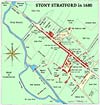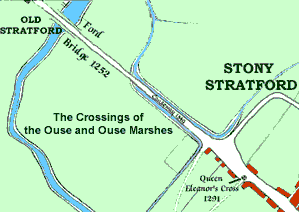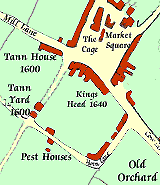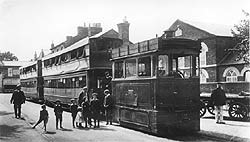![]()
The contents on this page remain on our website for informational purposes only.
Content on this page will not be reviewed or updated.
![]()
The contents on this page remain on our website for informational purposes only.
Content on this page will not be reviewed or updated.
|
GENERAL HISTORY OF THE TOWN |
|||||||
| General History of Stony Stratford through the Ages |
click here for link to map
 |
||||||
| From Roman times onward, river transportation was as important as travelling by road - possibly more so in places where roads were sparse or the terrain rough, as in marshy or hilly country. A river crossing therefore became a place of great importance, and Roman relics found at Old Stratford may allude to a possible guarded crossing or check-point of sorts where Watling Street crosses the River Ouse. (To read more about the Romans and Stony Stratford, click here) | |||||||
 Following the Romans, we have a gap in our historical knowledge. Although Stony Stratford was not itself mentioned in the Domesday Book of 1085/87, the settlement was forming and in 1194, at the time of King Richard I, it first appeared in records with the foundation of a market in that year - when a market charter was granted. Travellers were almost certainly passing through the town then, and may well have been held up crossing the Ouse marshes as this was the first major river crossing since London. The High Street in Stony Stratford widens on the spit of gravel extending towards the river, suggesting an early street market. Following the Romans, we have a gap in our historical knowledge. Although Stony Stratford was not itself mentioned in the Domesday Book of 1085/87, the settlement was forming and in 1194, at the time of King Richard I, it first appeared in records with the foundation of a market in that year - when a market charter was granted. Travellers were almost certainly passing through the town then, and may well have been held up crossing the Ouse marshes as this was the first major river crossing since London. The High Street in Stony Stratford widens on the spit of gravel extending towards the river, suggesting an early street market. |
|||||||
By Norman times (1066 -1100) Stony Stratford had become a market town boasting two churches, a market square and Horsefair Green (the latter was not mentioned before 1400). The town was unique in Buckinghamshire in having two parish churches - St Mary Magdalen's and St Giles'. (For more information on the two churches, see the Town Tour) |
|||||||
| The town had many spellings and derivations - in 1202 Stony Stratford appears as Stani Stratford. In 1257 Stony Stratford appears to be the accepted form, although Stretteford is quoted in 1290. As early as 1296 the northern section of the town was recorded as Old Stratford. It was 1270 when the first shop is mentioned in Stony Stratford, and then a capital Messuage in 1300. In 1391 a 'grant of pavage' was issued for four years to repair the King's Highway between the two Stratfords (probably Fenny & Stony). It wasn't until 1555 that any national policy was forthcoming - when a Parliamentary act placed obligation upon each Parish for maintaining its own highway by 'Statute Labour' i.e. the labour and equipment to be provided gratuitously for one week in the year by the parishioners working under the (unqualified) Parish Surveyor. In actuality, this probably involved tipping a few loads of stones into the deepest and muddiest holes! The Manorial records show Churchway appearing several times between 1373 and 1386, the Stone Bridge (called Stanbrygge) appears in 1380, Mill Lane (called Millepathus or Myllepath) occurring in 1335. See Map below. | |||||||
 There is considerable speculation to the exact site of the early hospital (thought to be a Leper isolation hospital) and Chapel of St. John, which was near to the bridge over the River Ouse. The recreated map of Stony Stratford in 1680 (see illustration - right) indicates the presence of "Pest Houses" (probably 'plague houses' - for the isolation of those suffering from the disease) on the edge of town near Horn Lane. |
|||||||
| Stony Stratford in the Wars of the Roses
Watling Street continued to be a major thoroughfare in the late medieval period, being the major road from London to Cheshire and north Wales, also allowing access to Lancashire and the region west of the Pennines. Like the Romans before them, medieval armies marched along it to and from London on campaigns in the English and Welsh regions. Stony Stratford was involved in two key episodes during this period.
Edward was triumphant and reigned till 1483. His sudden death however brought about another struggle for the throne. His heir Edward V was still a young boy, and on his journey to London for his Coronation was met at Stony Stratford by his uncle Richard of Gloucester (Edward's brother and the nominated "Protector" in Edward's minority) who took him into a protective custody from which he never emerged alive! The general outrage that this caused was one of the contributory factors which saw Richard lose his throne and his life in 1485. For details of the former inn in Stony Stratford where they met, see Point 18 of the Town Tour |
|||||||
The many Inns and Hotels of Stony Stratford Throughout the ages, Watling Street and its important crossing over the River Ouse have created the need for services for travellers and pilgrims. The intriguing Grilkes or Griks Herber or Inn may have some connection with Thomas Le Grik (the Greek) who witnessed documents dated 1296 and 1298. In 1349 William Grik (brother of Thomas) was Chaplain at Stony Stratford. Around that same time, the Cok or Coccus family was strong in the town and it is thought that the Cock Hotel may have its origins with the family name. (See Point 13 of the Town Tour) The earliest Inn mentioned was Grilkes Inn, in 1317, located most probably near the south end of the bridge on the west side. This is thought to be the site at 185 High Street which became the Angel and latterly the Barley Mow Inn and is now a private residence. (See Point 9 of the Town Tour) With the growth in the number of travellers, the number of inns began to multiply rapidly through the fifteenth, sixteenth and seventeenth centuries: The Cross Keys (1475), The Rose & Crown (1480), The Swan (1526), The Cock (1529), The White Horse (1540), The George (1609), The White Hart (1615), The King's Head (1640), The Crown (1666), The Barley Mow (1667) The Talbot (1680) and The Angel (1693) followed by many others. It is difficult to be exact about the numbers of inns and their precise location, as many changed their names over the years, causing confusion as to whether they were new inns, or had simply been re-named. |
|||||||
|
|||||||
| Stony Stratford and the Coaching Trade
At its peak, Stony Stratford had 30 or more stage-coaches per day passing through the town, all of which required servicing with food, horses and accommodation. Inns thrived, and as the coaches pulled into the town, the Ostler from the designated Inn would take care of the horses, providing hay, food, water, stabling and arranging any necessary blacksmith work. Coaches carrying mail would also stop off on their journey. The visitors would require overnight accommodation, food and ale, and any other services a traveller would need. Floods or bad weather meant that travellers were forced to stay longer in the town, which was good business for the merchants of Stony Stratford! The most notable of Inns amongst the town's 50+ establishments were two hotels called The Cock and The Bull. During stops overnight, or for meals en-route, news and gossip would be passed on. Like all good stories, as they were passed on they were exaggerated and padded out as news travelled between the two Inns, and so the phrase 'cock and bull story' came to be applied to any such exaggerated story. Local legend has it that the Cock hotel is the 'cock' of the nursery rhyme 'Ride a Cock Horse to Banbury Cross, to see a fine lady upon a white horse'. The lady is thought to be Celia Fiennes, who travelled to every county in England recording her experiences in her diary as she went. (For further information about the Cock Inn and the Coaching trade, see Point 13 of the Town Tour) The many inns of Stony Stratford spawned the following lines: The Prince of Wales and The Duke of Edinburgh minus The Coach and Horses, but both wearing the leaf of The Royal Oak rode past The Foresters Arms on a White Horse to see The Fox and Hounds meet at The Barley Mow; when they found it to be a Cock and Bull story. The Angel sent a message saying that The Case is Altered and advising them to chop The King's Head off and take The Crown and retire with The George to The Plough, dine off a White Swan and remain there the night as The Red Lion might be prowling around; have a good night's sleep and don't awaken until The Rising Sun came peeping through the windows in the morning. Trade Tokens Trade tokens were issued in the 17th century between 1647-1672 and were not legal tender, but were only a token or acknowledgement that the person who issued it did so because he either did not have money for change (actual money was scarce) and that he would be willing to take it back again at any time. Money and coinage was sparse at that time and silver pennies and farthings were not often used by the poorer people, so the illegal issue of token money began during the reign of King Charles the First, 2 years before his execution in 1649. Although outlawed, the tokens were in use for around 25 years.
On 1st September 1672 the manufacture and circulation of tokens was declared a penal offence and thus ceased. Many of the issuers of the tokens refused after that date to accept their own tokens back again, and so many poor people were left even poorer. The tokens themselves were made of brass, copper or other base metals and were stamped with the individual stamp of the issuer and his trade. Stony Stratford had between 12 and 15 trade tokens, and these would have been issued to travellers by innkeepers and tradesmen. Many of the tokens were then taken on the travellers' onwards journey and never returned. A clever move on the issuers' part. The County Museum at Aylesbury has a full collection of trade tokens.
The dashed line is the county boundary between Northamptonshire (left) and Buckinghamshire (right). When compared with the 1680 map (above) it will be seen that the town hadn't grown much. 1838 saw the coming of the railways, and the start of the decline in the trade of towns like Stony Stratford, which had thrived on the business of travellers by road, many of whom stayed at the coaching inns and hotels. However, the new form of transport had a counterbalancing effect in the later part of the 19th century. The decision of the London & Birmingham Railway (later the London & North Western Railway) to site a works factory in nearby Wolverton meant that a high-profile engineering facility arrived in what had been a mainly very rural area. The rise of the railways - and the industry they brought with them - also coincided with poor harvests and a decline in agriculture in the middle decades of the century. The net result was a dramatic growth of towns like Wolverton, New Bradwell and Stony Stratford and a decline in many rural villages - several losing up to 30% of their population. |
|||||||
| The Annual Hiring Fair
Every year in Stony Stratford just before Michaelmas would be the Annual Hiring Fair (also known as the Statute Fair) - a highlight in the town's calendar with feasting and fun. It was held in the market square, where men and women wearing their finest clothes and neatly presented, from all trades would gather in the hope of securing another year of employment. Michaelmas signalled the end of the harvest when workers would have finished their work in the fields. Servants, farm workers, butlers, cooks etc. would all gather in their designated area of the market place for their profession, wearing an emblem of their trade in their lapel. For example a farm worker may display a piece of corn, and a servant a piece of a mop etc. Cattle was also sold at these fairs. Similar fairs were held all over the country - a notable example being the Stratford upon Avon 'Mop Fair'. The ladies and gentlemen would walk around examining the eager faces and would choose the strongest and healthiest looking and engage them for a year's employment. The emblem was then swopped for a ribbon and a shilling as a goodwill token, to be spent at the fair. The ribbon would display that the person had been hired for employment. Once the business had been concluded, it was time for some fun! Coconut shies, brandy snap stalls, and even tubes of water (for putting down girls' necks) were popular - as these were a strange but common show of interest or affection! Much drinking and lots of food including spit roasts were the main treat of the day. |
|||||||
Horsefair Green This area of land was formally established in 1787 when the enclosure Act for Calverton (which included this part of Stony Stratford) decreed that 'the piece of land called Horsefair was to remain open and unenclosed'. From 1622 onwards on a Friday there had been a weekly fair of horses (hence the name Horsefair). These fairs ceased to be held by 1792, however, and the Lord of the Manor lost a useful source of income. The Horsefair Green land remained preserved for the public, but unfortunately no-one had the responsibility for looking after it. The Lord of the Manor, via the Great Court Leet of Manor was at pains to prevent incursions onto the land from whatever source. The Calverton Court Rolls from 1836 to1896 record several instances. On 28 October 1857 the Great Court Leet with its sworn Jury and Homage recorded that: "The timber lying on the Horsefair ought not to be there and is a nuisance." The sawpit was ordered to be filled in, and a year later two residents, Mrs Warren & Mr Knighton were ordered to remove their gardens on the Horsefair itself before 1 January 1859. In 1896 the last Great Court Leet and Jury was held. In 1901, the Lord of the Manor, who was by now receiving no market tolls, despite being apparently held financially responsible for the general upkeep of Horsefair, sold 'All and every his manorial rights in or over the Market Square, Silver Street and Horsefair Green' to the Stony Stratford Street Commissioners. It was then that Horsefair was fenced, tidied up and began to be one of the most charming parts of Stony Stratford. The War Memorial Garden was completed in 1922.
For pictures of the War Memorial, see Point 3 of the Town Tour |
|||||||
In 1871-1873 Edward Swinfen Harris the Architect built the Church of England School (now the Plough Inn), with the schoolmaster's house to the left, where the Wolverton Road meets Watling Street (now called London Road). Though the school no longer functions as such, Swinfen's memory is preserved in the Swinfen's Court development on the opposite corner where the High Street meets London Road. (See the section on Shops) |
|||||||
 In 1886, with the rise of Wolverton Works and the increase in the population of both Wolverton and Stony Stratford, some of the world's largest tramcars - each holding 100 people - began operating between Stony Stratford and Wolverton. For the story of the Stony Stratford tram, click here
|
|||||||
| The River Ouse & Flooding The river was made shallower by dropping stones into it, which reinforced the riverbed and made the water more shallow - this could be partly the reason why it was called 'Stony' Stratford. Travellers preferred to cross the Ouse during the safety of daylight and so the hotels and inns benefitted and thrived in the town. On flood days, travellers' journeys could be delayed, which proved more lucrative for the merchants and innkeepers of the town! Bridges were built and then unmaintained and left to fall into disrepair. Men were expected to give a few days of their time each year to maintenance of the roads. This was very unpopular, as repairs were normally carried out in good weather, just at the time when work was most plentiful on the farms etc. The old bridge collapsed around 1830 under the strain of wagons crossing which were carrying goods for making plate glass, on their way from London to Birmingham. It took forty horses to drag the wagons out and up the hill to Old Stratford. In 1823, the year of the great flood, a stage coach overturned on the 8th of November and the passengers were only just saved. In 1834, Parliament passed an act for a new bridge. The level of the road and the bridge was raised to help prevent flooding.
The highest summer flood known was in June 1903 when the waters reached from Passenham to Cosgrove and from the Bridge up the High Street. Unhappily, on this occasion the sewerage system backed up and not surprisingly, the results were most unpleasant! The 'Ouse Draining Board' was formed to organise the cleaning of the rivers on farmers' land, but their powers to enforce were weak and the Board was never wholly successful. |
|||||||
Days of Pride
1913 was a stirring time for the residents of Stony Stratford. Over the previous decade there had been a gradual but significant rise in political tension across Europe. Events were moving towards a conflict which subsequently became known as The Great War, and later The First World War. As armed forces across Europe gradually heightened their state of readiness, the Army held a massive exercise in the area and over 13,000 troops were encamped around Stony Stratford. In an echo of the Roman legions and medieval armies which had preceded them in earlier centuries, regiments of the British Army marched along the old Watling Street, over the river at Stony Stratford, and on to their final destinations. The impact which this had is reflected in the photos of the time, such as the one shown here. People stopped amidst the routine of their daily lives to watch the spectacle of the military march-past. To read and hear the full story of the effect of the manoeuvres, and the history of Wolverton & New Bradwell in the First World War, see the Living Archive feature "Days of Pride" |
|||||||
| The Later 20th Century
The First World War (1914-18) marked the high point for the industrial areas near Stony Stratford. Wolverton Works was at its zenith in terms of workforce and production, and many of the workers lived in Stony Stratford. With the ending of the Great War people had to come to terms with the many deaths that had occurred on the battlefield. Industry had to reorganise and the 1920s and 30s were not good times for the world economy as the stock markets crashed, millions were made redundant, and protests began. Most of the men of Wolverton Works joined the General Strike of May 1926. The Tram stopped running and the service was never reinstated.
As things began to recover in the late 1930s, the Second World War came. Wolverton Works turned its hand to all sorts of things in support of the war effort : trucks were converted to armed escorts; plane wings were even constructed and repaired in the great sheds at the Works. Mercifully, there was very little bombing in the area. When peace came in 1945, people hoped for a better future. However, the workforce at Wolverton was reduced further. Stony Stratford had not altered substantially through most of the 20th Century, but in 1967 plans were announced to build the new city of Milton Keynes: 100,000 people in a largely agricultural area which incorporated several established towns and villages. Bletchley, Fenny Stratford, Wolverton and Loughton were some of the ones affected. Newport Pagnell opted out. Stony Stratford opted in. The new development of such a large area meant new opportunities, new jobs and new housing, and was a boost for established communities like Stony Stratford. It has meant that large-scale facilities and employment are available within easy commuting distance, and also that the town can preserve its traditional character. |
|||||||
|
|
|||||||